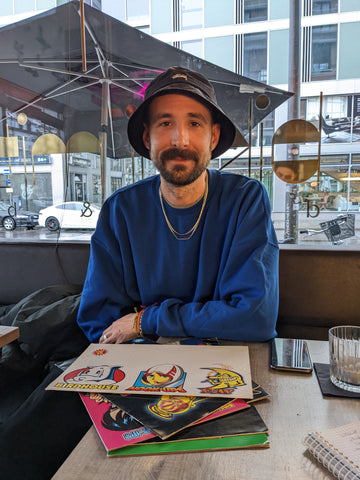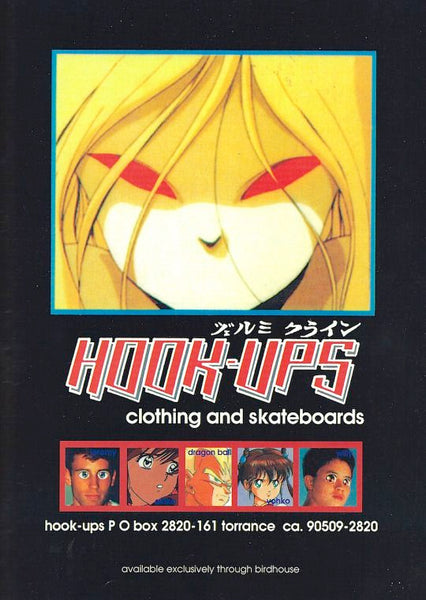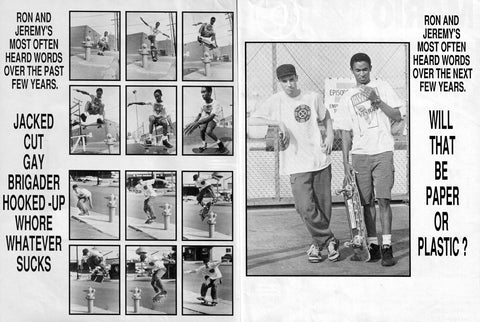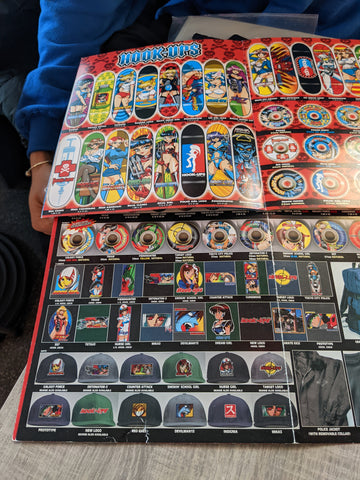
Brand History – Hook-Ups
Hook-Ups' gaudy skateboards, caps and (especially) T-shirts and hoodies are legendary. To find out why skater Jeremy Klein's brand was way ahead of its time in the '90s, we talked to an expert on the occasion of our Hook-Ups Drop: Taran (36) from The Ishincroyable in Munich, who is not only a busy vintage connoisseur, but also a Hook-Ups collector.
Taran (The Ishincroyable)
Double Double Vintage: Do you remember the first time you noticed hook ups?
Taran: It was on a Tech Deck fingerboard! In our school, around 1999/2000, everyone had a fingerboard. And with the graphics on it, Hook-Ups stood out the most out of all the labels. Because they had these anime graphics.
I started skating at that time and then we always went to Goodstuff, which was a legendary skate store here in Munich. There were also the skate decks from Hook-Ups, but they were unaffordable for me. I always shopped in the reduced corner (laughs)!
What I found so cool about Hook-Ups back then were the graphics: I skated. And I liked watching anime and reading manga. Akira and Cowboy Bebop, for example. And Hook-Ups closed that gap between anime and skating perfectly.
Old advertisement from Hook-Ups
Double Double Vintage: I actually knew the decks around 2000, but no merch. Were the clothes available at all in Germany back then?
Taran: The merch was sold here in Germany. But it was pretty expensive. For the kids it was too expensive anyway. And for adults maybe too expensive to skate with it. So maybe you rather watched skating in your hook-up shirt (smiles).
Double Double Vintage: When was the first time you owned a piece of Hook-Ups clothing?
Taran: Actually never until "now." So it's only in the last few years that I've been able to catch up with this passion because now you have a little more money than when you were younger.
Double Double Vintage: Can you tell us a little bit about the history of hook-ups?
Taran: Sure. So Jeremy Klein, the head behind Hook-Ups, was a skater at World Industries and then in the Birdhouse Crew. You know them from the "Birdhouse Projects" videotape, for example. The only video, by the way, where Tony Hawk skated street instead of halfpipe.

Jeremy Klein and Ron Chatman, still at World Industries back then
Jeremy Klein did art direction at Birdhouse and then started Hook-Ups in the mid-90s. But don't pin me down to the year. Hook-Ups started out with just T-shirts. You know, there was a lot of "do it yourself" in it, as is often the case with skating. Printing shirts was just easier than making decks. Jeremy Klein also benefited from Tony Hawk's infrastructure. (Taran puts a stack of magazines on the table)
These are old catalogs from Birdhouse Distributions. They distributed Birdhouse, Flip, and Hook-Ups. You can recognize the first catalogs because they weren't numbered yet. (Taran pulls out a newer catalog) This is a later catalog, where a new artist took over at Hook-Ups. He took over the "logic" of Jeremy Klein's first anime shirts in the beginning, but later changed and Americanized it.
Double Double Vintage: What do you mean by "Americanized" in that case?
Taran: That's when the characters' eyes got even bigger. And generally all the proportions: Eyes, breasts and so on. At the beginning of Hook-Ups, Jeremy Klein used the visuals of real anime (opens a page in the catalog).

(Taran's vintage Hook-Ups catalog)
Double Double Vintage: Ah yes. This one looks like Battle Angel Alita. And the graphic of "Tokyo City Police" here in the catalog is actually "Dominion Tank Police" mixed with "Gunsmith Cats".
Taran: Right, for example. And when Blitz Distribution took over distribution of Hook-Ups in 2002, the look in general also became more decoupled from real anime that Jeremy Klein had cited before. This was then partly typical USA. One example is the allusion to the "Hooters" girls from the fast food chain.
Those were the shirts with the white size tag (size label on the neck, editor's note) with a cross on it. Before that, there was the Kanji tag, around 1996. The tag with the rabbit ears came in 1997. And in 1998 to 1999 came the Crosshair tag with the target. They were a little wider. The tag with the skull was introduced in 2001/2002. And (grabbing the back of his neck to show the tag from his Hook-Ups shirt) in 2007 the shirts then had the writing on them. Oh yeah, in the very beginning the shirts were printed on Anvil blanks without custom tags. Just like Birdhouse. And the hoodies were from "Soft Fleece" in the beginning.
Double Double Vintage: How can you actually recognize fake Hook-Ups shirts?
Taran: The size tag is an indication. The era with the skull tag is the most faked. Those are the ones with the skull on a red cross. Then if the tags don't have a size tag, they're fake. And there are no backprints on real shirts from Hook-Ups. But the fakes often have motifs on the back. And you can see it on the collar: It's often thinner on fakes.
Double Double Vintage: I was honestly surprised when I saw the other day that Hook-Ups is still active. For a long time the brand was a bit "indifferent". Why do you think Hook-Ups is so popular again now?
Taran: The shape of the shirts definitely plays a role. It's always nice and boxy. And the quality and cotton of the old pieces is awesome. And of course it also helps when a Travis Scott or Jonah Hill wears hook-ups in public. For me, the time when you skated yourself just has nostalgia factor. It was out with friends, sharing Lipton Iced Tea... that's still a factor.
And today, skating is also much bigger. There are kids coming up, they see old and new graphics and Hook-Ups still stands out.

Double Double Vintage: How does Hook-Ups make it stand out today?
Taran: It's like the Marvel universe: there are different characters on the graphics. You can collect those things. And the fact that the graphics are from anime also plays into it. The visuals just have a hype. These are still the freshest graphics.
World Industries, for example, also has cool graphics with Flameboy and Wet Willy. But that's just repetitive. Hook-Ups is nicer in terms of aesthetics. I also don't like when there is so much going on on shirts. These small graphics are cooler. Meanwhile it is also harder to find old pieces from Hook-Ups. The joy is then even higher when you find it for a reasonable price. You can also dive into the creative universe of Jeremy Klein with the motifs.
The graphics also have shock factor. Of course the sexualization, but also such things as alcohol and smoking: People don't care so much about that here in Europe, but in the U.S. it's provocative. The counter culture idea of skating still comes through. Also with Flip Skateboards: Such a graphic with a coke-snorting half-moon is somehow punky.
Double Double Vintage: In your eyes, does the "Hook-Ups" brand overshadow the legend of Jeremy Klein as a skater?
Taran: I never celebrated Jeremy Klein's skate style that much. It wasn't very technical. But it was very brave. He just did his thing. For example, there's the "Destroying America" video: They set up a mini ramp in front of a bus stop, prepared the bus stop and grinded on it.

They made things skateable, on which you can not actually skate. Something like a neon sign from a fast food restaurant, for example. They weren't the coolest tricks, but they put on a great show with balls of steel.
While Rodney Mullen did an "Impossible Flip" and was the most technical guy, Jeremy Klein went for the rail. He grinded. And down. He embodied this oldschool skate style. The objective always was straight to the face.
Double Double Vintage: Cool, thanks a lot for the interview!
PS: In our store you can now get hold of deadstock shirts from Hook-Ups: Better be quick!
By the way, you can get more memories of skatestyle in the 90s and early 2000s in episode 16 of the podcast "Vintage am Mittag", which is published by Taran and others:
Comments
-
Liquid error (snippets/article_comments line 29): include usage is not allowed in this context
Liquid error (snippets/article_comments line 29): include usage is not allowed in this context
Liquid error (snippets/article_comments line 29): include usage is not allowed in this context
Liquid error (snippets/article_comments line 29): include usage is not allowed in this context